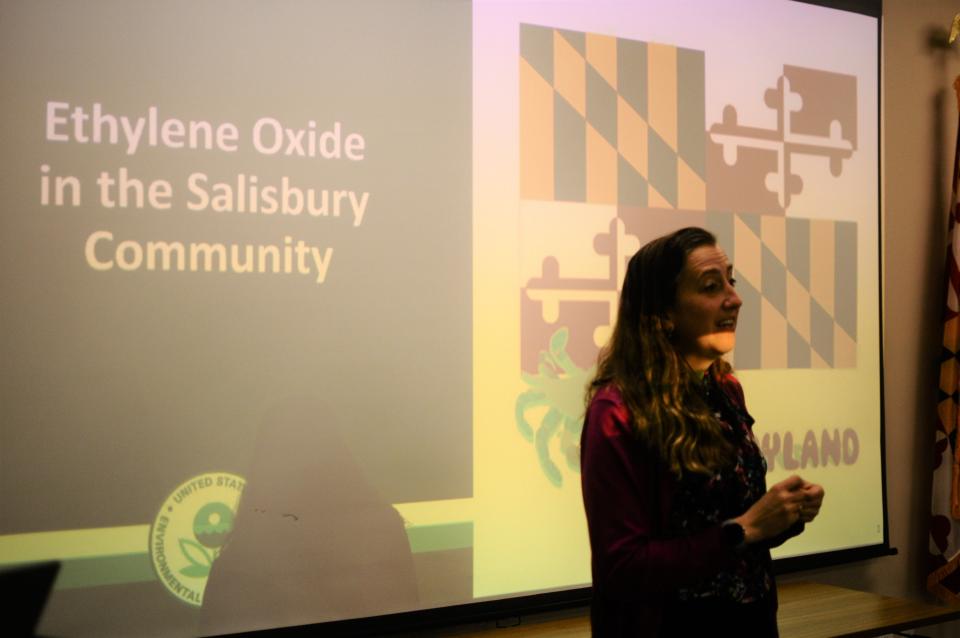How safe is chemical emission from Salisbury sterilizing company? EPA updates community
The Environmental Protection Agency returned to Salisbury on Thursday evening to update the public on new regulations stemming from health risks from the chemical, ethylene oxide or EtO, from Trinity Sterile Inc.
According to the EPA, the 201 Kiley Drive site uses ethylene oxide to sterilize medical equipment and materials. The danger comes when there are lifetime cancer risks of 100 in a million or greater from breathing air containing the material emitted from the facility, per the EPA. That is the same as one additional cancer case in 10,000 people.
The EPA also noted the company is currently in compliance with all regulations governing EtO emissions.

A lifetime cancer risk of 100 in a million means that, if 1 million people were exposed to this level of oxides in the air 24 hours a day for 70 years, 100 people would be expected to develop cancer from that exposure.
According to Madeline Beal, senior risk communications advisor in the Office of Public Affairs for the EPA, the agency learned in 2016 the chemical was dangerous when inhaled. That led to a study in 2018 in areas around the country where other communities were exposed to collect further data.
In the coming weeks, EPA officials expect to propose air pollution regulation to protect public health by addressing EtO emissions at commercial sterilizers. The agency is sharing EtO emissions data and information with the public to solicit feedback and improve public understanding of the risk.
More on the company's pastEPA lists Salisbury facility as among 3 toxic air polluters in Maryland
Once new regulations are adopted, facilities like Trinity Sterile Inc. will have a deadline to become compliant to revised rules.
"There are two ways EtO can leave the facility. The first is once it's used to sterilize something, it is drawn into a controlled system, and they clean it out of the air. They capture it and break it down before releasing a considerably smaller amount called controlled emissions. Other unplanned leaks from the facility are called fugitive leaks," said Cristina Fernandez, Air Division director for the agency.
The difficulty in regulating commercial sterilizing businesses is often their physical location. With many of these companies situated in communities rather than in industrial parks, they often go under the radar. Moreover, the facilities themselves often do not know a leak is occurring until independent monitoring of the area is completed.
"While we are worried about (exposure) to ethylene oxide in communities like Salisbury, it doesn't stick around for a long time," Beal said. "Reducing the amount of the EtO coming from the facility will reduce the risk immediately. This analysis was completed in July 2022 and will help us change the rules that will govern how much EtO can come from these types of facilities."
Suna Yi Saviscak, Air Quality Permits Program manager for the Maryland Department of the Environment, noted the current scrubbers used by the company reduce EtO emissions by 99%.
More on air quality and poultryEastern Shore poultry industry keeps growing, with turbulent mix of successes, challenges
"The current permit also limits the use of EtO by having them use only a certain amount per batch for the scrubber to be operating at that efficiency. Emissions from the aeration rooms and the sterilization chambers cannot be vented simultaneously because we want to make sure the scrubber isn't overloaded," Saviscak said.
With many of the questions from the public addressing the outreach efforts by the agency, EPA officials admitted there has been limited individual contact with the impacted community, but that efforts are ongoing along with improved monitoring practices.
This article originally appeared on Salisbury Daily Times: EPA updates Salisbury residents on industrial sterilization pollution

